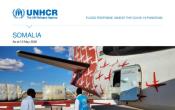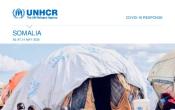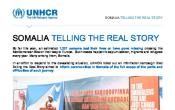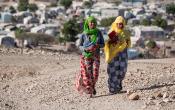Somalia
Operation: Somalia
Location
{"longitude":45,"latitude":6,"zoom_level":0,"iso_codes":"'SOM'"}
By clicking on the icons on the map, additional information is displayed.
The boundaries and names shown and the designations used on this map do not imply official endorsement or acceptance by the United Nations.
Key Figures
| 2019 year-end results | |
| 77,000 | IDPs received emergency shelter assistance through distribution of 12,800 emergency shelter kits and 10,000 vouchers for shelter material. |
| 250 | transitional shelters and 300 permanent shelters were constructed for IDPs. |
| 205,000 | IDPs benefited from core relief items (CRIs) through distribution of 34,300 units of CRIs and 20,500 cash vouchers for CRIs. |
| 12,400 | Out of a total of 66,900 refugees and returnee children, 12,400 (19%) had access to education, including primary and secondary education. |
| 80% | of refugees had access to primary health care services. |
| 11,100 | people of concern received assistance to prevent and respond to sexual and gender-based violence (SGBV) including psychosocial support, community-based protection, awareness sessions, health care access, livelihoods assistance, and legal aid. |
| 2020 planning figures | |
| 100% | of refugees and asylum-seekers will be individually registered in the biometric identity management system |
| 90% | of registered refugees will have access to primary health care |
| 80% | of registered school-aged refugee children will be enrolled in primary education |
| 400,000 | IDPs will receive emergency protection services and life-saving shelter/NFI assistance |
| 108,000 | Somali returnees will benefit from reintegration support through an area-based ‘whole-of-society’ approach |
| 17,000 | Somali refugee returnees will receive return packages including cash grants, education support and NFIs |
| 6,800 | women and children will receive services related to prevention of, or response to, SGBV |
People of Concern
2%
Decrease in
2019
2019
| 2019 | 2,712,622 |
| 2018 | 2,769,028 |
| 2017 | 2,187,585 |

[["Refugees",17883],["Asylum-seekers",17789],["IDPs",2648000],["Returned IDPs",22555],["Returned refugees",6243],["Others of concern",152]]
Loading ...
Somalia
< Back
2019
{"categories":[2015,2016,2017,2018,2019,2020],"budget":[99.153880316,165.91668118,118.079818567,186.38427484,183.29162524,154.37925103],"expenditure":[36.1882683,50.90649389,77.0882735,64.84599844,66.67223914,null]}
{"categories":[2015,2016,2017,2018,2019,2020],"p1":[44.514196076,93.4138341,55.025162457,79.06649113,34.26107633,42.8765389],"p2":[null,null,null,null,null,null],"p3":[13.09633044,34.86243341,23.49323017,58.44954597,112.6362472,76.66090962],"p4":[41.5433538,37.64041367,39.56142594,48.86823774,36.39430171,34.84180251]}
{"categories":[2015,2016,2017,2018,2019,2020],"p1":[19.02820407,29.51135868,43.41707683,33.68236103,12.93800572,null],"p2":[null,null,null,null,null,null],"p3":[6.92298829,8.31500207,17.82340434,20.23522218,27.53703574,null],"p4":[10.23707594,13.08013314,15.84779233,10.92841523,26.19719768,null]}
Loading ...
CHOOSE A YEAR
- 2014
- 2015
- 2016
- 2017
- 2018
- 2019
- 2020
Operational context
As part of its recovery following more than two decades of conflict, Somalia continued to welcome returning refugees with the support of UNHCR – both through the voluntary repatriation programme and spontaneously. Despite progress, challenges remained, and at the end of 2019, some 2.6 million people were internally displaced and 820,000 Somali refugees resided in other countries across the Horn of Africa and Yemen.The operation continued to support the Government in providing protection and assistance and working towards the attainment of durable solutions for refugees, asylum-seekers, returnees and IDPs, working in close partnership with international and national actors.
The operation advanced the Comprehensive Refugee Response Framework through partnerships with the Government, United Nations and NGO actors in the sectors of health, education, livelihoods, and legal assistance and law development. In this regard, UNHCR maintained a close working relationship with relevant government departments and other relevant authorities in the country.
Population trends
By the end of 2019, Somalia was home to nearly 35,700 registered refugees and asylum-seekers, 37% of whom were of Yemeni nationality and 61% Ethiopian, while 2% represented other nationalities. Women and children constituted some 68% of people of concern.Since December 2014, more than 129,000 Somali refugees had returned, including some 5,500 during 2019 (more than 2,100 of whom returned from Kenya through a facilitated process).
Key achievements
- A total of 35,700 refugees and asylum-seekers received multi-sectoral assistance in Somalia across the three regions of Puntland, Somaliland and South Central.
- In 2019, some 5,500 Somalis returned to Somalia from Kenya, Libya, Yemen and other countries. UNHCR provided all returnees with return packages.
- UNHCR processed nearly 130 refugee status determination cases pertaining to over 480 individuals. The files of some 160 individuals were submitted to Sweden for resettlement.
- More than 100 government staff were trained in different capacity-building initiatives.
Unmet needs
- Most refugees still had no prospects for local integration in Somaliland. Voluntary repatriation was not feasible for most refugees, especially refugees from Yemen due to ongoing conflict in the country. All these elements contributed to the continuing need for resettlement, exploration of complementary pathways and more funding for livelihoods programmes.
- The Somali operation received 36% funding in 2019. Due to limited funding, UNHCR was not able to implement most of the projects necessary to effectively support all returnees. Gaps included access to land, limited infrastructure and facilities like schools and health care in places of return.
- With large numbers of protracted IDPs and periodic natural disasters (i.e. floods and droughts), IDP response and assistance was estimated to cover less than 20% of total needs.
Working environment
Somalia is recovering after more than two decades of conflict but continues to face challenges. Some 2.65 million people remain internally displaced and a further 820,000 Somali refugees reside in other countries across the Horn of Africa And Yemen, as of mid-2018. Since December 2014, more than 120,000 people have returned to Somalia voluntarily. There are also some 31,000 refugees and asylum-seekers, mainly from Ethiopia and Yemen, registered in Somalia.The situation in Somalia remains precarious as a result of insecurity and recurrent droughts. Refugee returnees and IDPs live in congested settlements or temporary sites in cities such as Mogadishu, Baidowa and Kismayo. This has increased pressure on the already limited and overstretched basic services infrastructure and livelihoods opportunities available. This limited absorption capacity hinders return and reintegration.
Within the New York Declaration for Refugees and Migrants, the Nairobi Declaration and its National Plan, Somalia has made significant steps towards creating conditions for safe, sustainable and voluntary return of refugees and reintegration of IDPs and refugees in Somalia. Somalia adopted its National Plan (NAP) and has developed policies including the Draft National Policy for Refugees-Returnees and IDPs; the Land Distribution policy for Returning Refugees and IDPs; the National Disaster Management plan.
As return prospects for Somalis are increasing in the region, there is a need to scale up the development of basic services and infrastructure, building or restoring existing infrastructures systems to support the return and reintegration of displaced communities. Infrastructure investments are needed in particularly in the areas of water, sanitation, health and education in order to make returns sustainable.


























